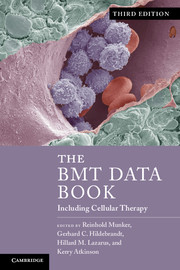Book contents
- Frontmatter
- Contents
- List of contributors
- Foreword
- Preface
- Acknowledgments
- Section 1 Basic science
- Section 2 Hematologic malignancies
- Section 3 Solid tumors
- Section 4 Nonmalignant disorders
- Section 5 Cellular therapy
- 20 Cellular therapy
- Section 6 Practical aspects and procedures
- Section 7 Complications
- Section 8 The BMT/SCT pharmacopoeia
- Section 9 HLA-testing and laboratory medicine
- Appendix Guide to the internet and literature databases relevant for BMT/SCT
- Index
- References
20 - Cellular therapy
Published online by Cambridge University Press: 05 August 2013
- Frontmatter
- Contents
- List of contributors
- Foreword
- Preface
- Acknowledgments
- Section 1 Basic science
- Section 2 Hematologic malignancies
- Section 3 Solid tumors
- Section 4 Nonmalignant disorders
- Section 5 Cellular therapy
- 20 Cellular therapy
- Section 6 Practical aspects and procedures
- Section 7 Complications
- Section 8 The BMT/SCT pharmacopoeia
- Section 9 HLA-testing and laboratory medicine
- Appendix Guide to the internet and literature databases relevant for BMT/SCT
- Index
- References
Summary
Basic principles
In this chapter, established cellular therapies (mainly DLI) as well as novel cellular therapies (regulatory T-cells, NK cells, cytokine-induced killer cells, dendritic cells, mesenchymal stem cells, induced pluripotent stem cells, and genetically modified T-cells) will be reviewed. A survey in Europe in 2008 showed that more than 1000 patients (about 60% autologous and 40% allogeneic) were treated with such novel cellular therapies. The major indications were cardiovascular, hematologic, neurological, and musculoskeletal. Here we will discuss cellular therapies relevant to blood disorders and SCT, and will exclude stem cells delivered for cardiovascular, orthopedic, or neurological indications.
BM contains several lines of cells including: hematopoietic stem cells, progenitor cells, and mature cells, such as B- and T-lymphocytes, monocytes, dendritic cells, and NK cells. Hematopoietic stem cells are valuable for rescuing hematopoiesis after high-dose chemotherapy and radiotherapy, which are toxic to stem cells. This high-dose therapy can be used for the treatment of leukemia and other malignant diseases. However, in the treatment of leukemia, the role of lymphocytes has already been described in the literature (Barnes & Loutit, 1957). Allogeneic SCT was seen as a form of adoptive immunotherapy (Mathé et al., 1965). In human patients, lower relapse rates were seen in patients who developed GVHD (Weiden et al., 1979), and the depletion of T-cells for prevention of GVHD was associated with an increased relapse rate (Goldman et al., 1988). The effect of T-cell depletion on the relapse rate was greatest in CML, less in AML, and least in ALL (Horowitz et al., 1990).
- Type
- Chapter
- Information
- The BMT Data BookIncluding Cellular Therapy, pp. 209 - 234Publisher: Cambridge University PressPrint publication year: 2013



